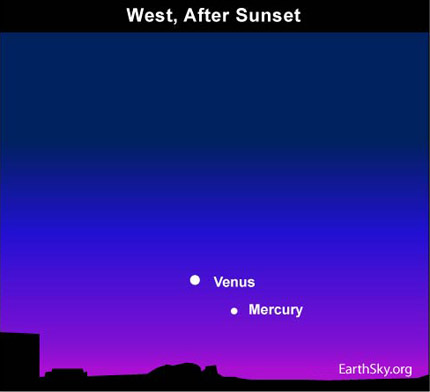Courtesy of EarthSky
A Clear Voice for Science
www.EarthSky.org
If you have never seen the planet Mercury before, now is time to do so. Find the planet Venus in the western twilight after sunset, and you are pretty much assured of spotting Mercury.
Venus is easy to find, because it is the third brightest celestial object to bedeck the heavens after the sun and the moon. Mercury, although considerably fainter than dazzling Venus, is still as bright as a first-magnitude star. If you can’t see Mercury with the unaided eye, try binoculars. Luckily, Venus and Mercury occupy the same binocular field for the next couple of weeks.
Here is how to catch Mercury, the phantom of twilight. First, find an unobstructed horizon in the direction of sunset. Shortly after sunset – say from about 30 to 75 minutes afterwards – look low in the western dusk for Venus and Mercury. These planets follow the sun beneath the horizon by the time that it gets good and dark. If you can’t see Mercury next to Venus with the unaided eye, aim binoculars at Venus to reel in Mercury.
Mercury, the solar system’s innermost planet, never strays far from the sun’s glare. On April 8, 2010, Mercury will be at its greatest elongation east of the sun, and setting a maximum amount of time after the sun. Your viewing window for watching these two planets in early April 2010 will increase to about 90 minutes after sunset. With Venus shining next to Mercury at dusk and early evening, these next two weeks may well be your best chance to catch Mercury in all of 2010!
Related:
Need a sky almanac? EarthSky recommends
Written by Bruce McClure
Other Links:
Astronomy Picture of the Day from NASA/JPL
The York County Astronomical Society
